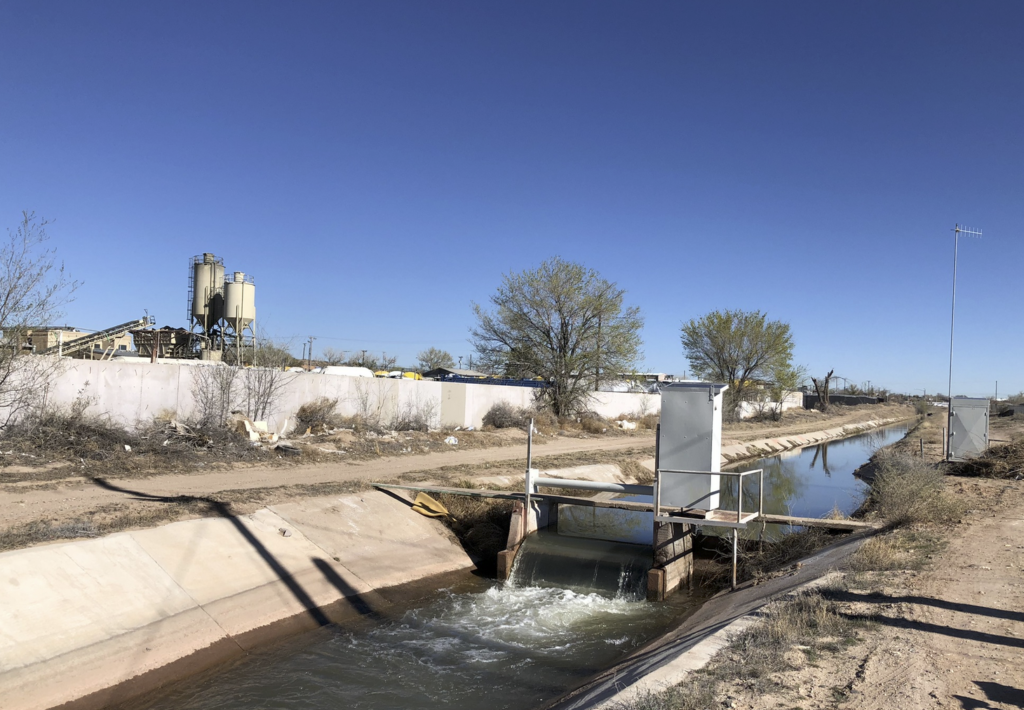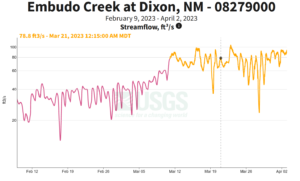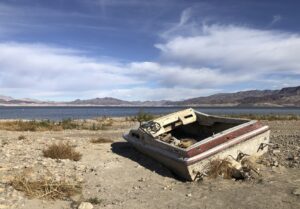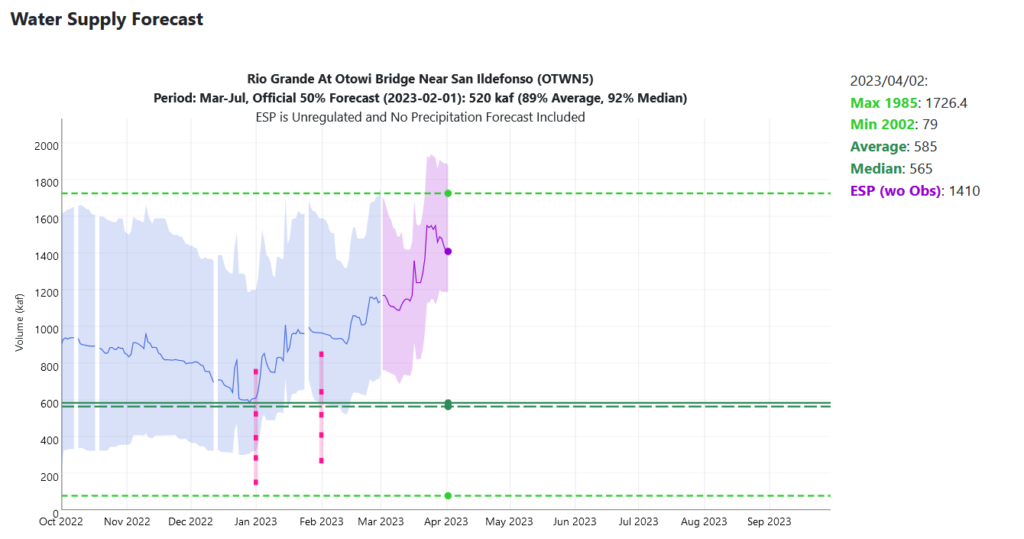
An urban river. Arenal Canal in Albuquerque’s South Valley
The ditches were flowing across Albuquerque’s valley floor yesterday as I criss-crossed them on a long, aimless bike ride, the first day it really felt like spring. The cycling challenge at this winter<->spring pivot point is clothing – layers for a morning start hovering just above freezing, with a pannier stuffed with the layers by the time I was down to shirtsleeves for my taco brunch.

Embudo Creek
My favorite gage at this time of year is Embudo Creek, just above its confluence with the Rio Grande in northern New Mexico. You can see the diurnal cycle of day-night melting, and the rising as the temperature warms. With the big snowpack, flows right now are well above the median. (Prof. Fleck note: The skewed nature of the data, with flows a lot higher on the high side than the lows on the low side, makes the mean – typically what we mean by “average” – less meaningful for a data like this. Hence median.)
The West Gulf River Forecast Center is forecasting Embudo Creek runoff at more than double the median this year.
The Embudo is just one little creek, but people live on it and built their lives around it. Of such creeks is the entire West built. Good to pay attention to one.
Colorado River at the start of April
The whole deadpool/wrecked speedboats emerging from the Lake Mead mud thing seems a bit of a quaint echo from a stranded past, as the Colorado River discourse shifts from how to protect the infrastructure from a dark cascade toward deadpool to “Which reservoirs should we refill, and by how much?”
The official CBRFC April 1 forecast hasn’t dropped yet, but the preliminary modeled numbers are up 3.6 million acre feet from March 1.
3.6 million acre feet.

Never forget.
That seems like a lot, but it is worth remembering that we’ve been overusing the river by about 1.5 million acre feet per year since the turn of the century.
This likely means a release from Glen Canyon Dam to the Lower Basin of 9 million acre feet (or more?) in 2023, which might be enough to re-submerge some of the wrecked speedboats. That would be nice, but I hope we don’t forget the visceral message they’ve been sending us.
Interior’s draft modeling results should emerge next week (perhaps April 10-11-12?), but the specific near term crisis they were meant to help us through – the possibility of a Glen Canyon Dam release of less than 7 million acre feet this year – is gone.
Yay.
Instead, the Basin community is wrestling with a “what shall we do with the extra water” question: refilling Flaming Gorge and the other Upper Basin reservoirs drawn down by DROA, erasing “operational neutrality” by solving the confusing mess of the relationship between how much water was held back in Powell to keep the dam from breaking, and how that affects Lower Basin shortage tier accounting. (Don’t ask me hard questions, it’s super confusing.)
In a really important way, the discussion has shifted from short term crisis management to long term, umm, I guess “crisis management” remains the right description? Raise your hand if you disagree.
Rio Grande at the start of April
The Rio Grande, which is getting my most focused thinking right now on account of the new book (see bike ride picture above), is in good shape. Usually at this time of year I shift from watching the snowpack to worrying about dry wind events, but this year there’s so gosh-darned much snow up there that I’m, like, “Meh, whatever, bring it on, spring!”

Otowi runoff via WGRFC – a very good year on the Rio Grande
I lot depends on spring winds now, and the rate of warming and meltoff. But that will just be the difference between a big year and a very big year.
My great hope is for overbank flows in the Middle Rio Grande, like we had in 2019. Those were super fun.
As always, a big thanks to Inkstain’s supporters for helping support this work.

When I worked on both the Colorado river system at the Rio Grande river system I could help to notice the differences between the products of the Colorado Badin River Forecast Center versus the West Basin Forecast Center. Both are excellent; the forecasting skills require deep knowledge, and science, hydrology and climatology, but what I did notice was that there was a market difference in detail and product quality, mostly due to the infusion of money into the Colorado Basin River forecast Center. I making the forecast on the Rio Grande similar to the forecasting products of the Colorado basin river forecast center with serve the Rio Grande community well.
Seems like the narrative is changing. Yes to Yes but.
John Check it out.
https://www.msn.com/en-us/news/us/a-long-dormant-lake-has-reappeared-in-california-bringing-havoc-along-with-it/ar-AA19n9PN?ocid=winp2fptaskbarhover&cvid=b5c77e9c29ee434abab44bf2969bd2f6&ei=29
Another excuse to procrastinate.
I don’t think our apprehension about the stability of our water supply lasts even a year. As soon as the crisis recedes, so does our willingness to solve our problems.
There’s a swinging bench along the river in Green River, Wyoming that you have to wade out to in overbank conditions. Hasn’t happened in several years. That’s what I’m hoping for this year. Another 18 inches of snow dropped there yesterday. Schools got a snowday in April. That hasn’t happened in my lifetime.
I am on team Powell 3600. My GUESS is that unregulated inflow to Powell for the water year will be 17+. Hoping all the upper basin reservoirs fill but was uncertain about Flaming Gorge, but now they have had extra snow falls who knows – it might reach limit. I think Powell will release 10 to Mead for the year which may get Mead up to 30+% given the Arizona component contribution…. Who knows maybe more?
Of note is the ground will absorb x amount of water so every extra inch of swe will/should go straight to runoff…. To reservoirs…..
Oh and I am on the east coast of Australia but have a morbid fascination with Powell after a visit in 2014. Interestingly the upper basin weather is opposite to our weather. So the last 3 years we have had record rainfalls and flooding while the basin was dry. Now we are having a dry spell here and surprise surprise the basin is having records.
Hope you get 3 similar years to this then everyone can relax for a while and focus on longer term water management.